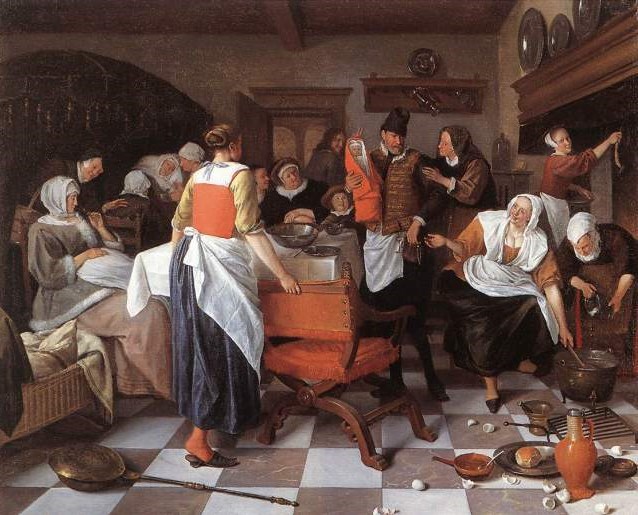

In this classic painting dated 1664 by Dutch master and contemporary of Rembrandt, Jan Steen, titled “Celebrating the Birth”, we see cuckolding en tableau. This scene is visually rich with cuckolding imagery. Note the grinning man miming the cuckold sign of the horns above the baby’s head. Interestingly, art historians determined the cuckold hand sign had been painted over during the 19th century. This defacement was likely ordered by a collector or curator who took offense to the cuckolding horns and viewed them as profanity. The painting was restored to its original status only thirty years ago.
The man illustrating the cuckold humiliation is believed to be the artist himself who inserted his likeness into the painting to add contrasting emphasis to the cuckold, an older man holding the newborn baby. Art scholars believe the baby to be a son. A celebration would traditionally be held to herald a male heir. However, this is obviously not the older man’s child, but the child of the man portrayed by the painter. Symbolic elements in the painting reveal more metaphor. The brass bed warmer conspicuous in the forefront of the painting, signified that coals in the bed warmer were keeping the bed warmed. It denotes a lack of marital sex. The older husband had lost his libido. The wife is not so much a powerful cuckoldress as a resourceful woman with no other options but to engage in sex with another man, driven to do so by her husband’s impotency in order to produce heirs or offspring.
The older man is holding quite a large purse which indicates some level of wealth. This wealth has enabled him to attract the younger bride and to provide for her. But the painter has added a few other elements which mock the supposed father. Namely that he is wearing an apron and holding a set of keys. Key holding in that time was the duty of the woman of the house, sometimes referred to as the chatelaine in larger households. Wearing an apron is a humiliating emasculation. Other symbolism includes the eggshells on the floor, eggs which had been cracked and used as ingredients to prepare a celebratory feast. The term cracking eggs was an expression for having sex in 17th century Europe. Obviously, the girl grabbing the phallic looking limp sausage hanging above the fireplace illustrates strong sexual innuendo. Note her gaze is deliberately directed outward to those viewing the painting instead of interacting with the family, midwife or other cooks. She wants us to be aware of the sexual farce unfolding before us.
